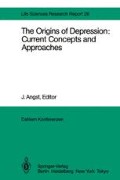Abstract
The opportunity to bring together a multidisciplinary group of scientists to consider the topic of animal models and their use in research on depression was unique. This report represents the deliberations of our group over a period of several days and should be considered as complementary to the four data-based papers dealing with details of specific animal model systems.
Access this chapter
Tax calculation will be finalised at checkout
Purchases are for personal use only
Preview
Unable to display preview. Download preview PDF.
References
Colpaert, F.C., Lenaerts, F.M., Niemegeers, C.J.E., and Janssen, P.A.J. 1975. A critical study on Ro 4-1284 antagonism in mice. Arch. Int. Pharmacodyn. 215: 40–90.
Gouret, C; Mocquet, G., Coston, A., and Raynaud, G. 1977. Interaction de divers psychotropes avec cinq effets de la reserpine chez la souris et chez le chat. J. Pharmacol. Paris 8: 330–350.
Hellhammer, D. 1983. Gehirn und Verhalten. Muenster, FRG: Aschendorff Publishing Co.
Hinde, R.A., and Spencer-Booth, Y. 1971. Effects of brief separation from mother on rhesus monkeys. Science 173: 111–118.
Hrdina, P.D., von Kulmiz, P., and Stretch, R. 1979. Pharmacological modification of experimental depression in infant macaques. Psychopharmacology 64: 89–93.
Jalfre, M., and Porsolt, R.D. 1982. Antidepressants and the limbic system. In Psychopharmacology of the Limbic System, eds. E. Zarifian and M.Trimble. New York: Wiley, in press.
Johnson, J., Sherman, A., Petty, F., Daylor, D., and Henn, F. 1982. Receptor changes in learned helplessness. Soc. Neurosci. Abst. 8:392.
Kaufman, I.C. 1977. Developmental considerations of anxiety and depression: Psychobiological studies in monkeys. In Psychoanalysis and Contemporary Science, ed. T. Shapiro, pp. 317–363. New York: International Universities Press.
Kaufman, I.C, and Rosenblum, L. 1967. The reaction to separation in infant monkeys: Anaclitic depression and conservation-withdrawal. Psychosom. Med. 29: 649–675.
Kling, A., and Steklis, H.D. 1976. A neural substrate for affiliative behavior in nonhuman primates. Bain Behav. Evol. 13: 216–238.
Kokkinidis, L., Zacharko, R.M., and Predy, P.A. 1980. Postamphetamine depression of self-stimulation responding from the substantia nigra: reversal by tricyclic antidepressants. Pharmacol. Biochem. Behav. 13: 379–383.
Kraemer, G.W., and McKinney, W.T. 1979. Interactions of pharmacological agents which alter biogenic amine metabolism and depression. J.Affect. Dis. 1:33–54.
MacLennan, A.J., Drugan, R.C., Hyson, R.L., Maier, S.E., Madden, J., and Barchas, J.D. 1982. Corticosterone: A critical factor in an opioid form of stress-induced analgesia. Science 215: 1530–1532.
Margules, D.L. 1979. Beta-endorphin and endoloxone: hormones of the autonomic nervous system for the conservation or expenditure of bodily resources and energy in anticipation of famine or feast. Neurosci. Biobehav. Rev. 3: 155–162.
Margules, D.L. 1981. Opioid and anti-opioid actions in the survival and reproduction of individuals. In Theory in Psychopharmacology, ed. S.J.Cooper, vol. 1, pp. 177–195. New York: Academic Press.
Mineka, S., and Suomi, S.J. 1978. Social separation in monkeys. Psychol. Bull. 85: 1376–1400.
Miyauchi, T., Kitada, Y., and Satoh, S. 1981. Effects of acutely and chronically administered antidepressants on the brain regional 3-methoxy-4-hydroxy-phenylethyleneglycol sulfate in the forced swimming rat. Life Sci. 29: 1921–1928.
Porsolt, R.D., Anton, G., Blavet, N., and Jalfre, M. 1978. Behavioural despair in rats: a new model sensitive to antidepressant treatments. Eur. J. Pharmacol. 47:379–391.
Porsolt, R.D., Berlin, A., Blavet, N., Deniel, M., and Jalfre, M. 1979. Immobility induced by forced swimming in rats: effects of agents which modify central catecholamine and serotonin activity. Eur. J. Pharmacol. 57: 201–210.
Porsolt, R.D., Bertin, A., and Jalfre, M. 1978. Behavioural despair in rats and mice: strain differences and the effects of imipramine. Eur. J. Pharmacol. 51:291–294.
Rasmussen, K.L.R., and Reite, M. 1982. Loss-induced depression in an adult macaque monkey. Am. J. Psychiat. 139: 679–681.
Reite, M., Harbeck, R., and Hoffman, A. 1981. Altered cellular immune response following peer separation. Life Sci. 29: 1133–1136.
Reite, M., Short, R., Seiler, C; and Pauley, J.D. 1981. Attachment, loss, and depression. J. Child Psychol. Psychiat. 22: 141–169.
Robson, R.D., Antonaccio, M.J., Saelens, J.K., and Liebman,J. 1978. Antagonism by mianserin and classical a-adrenoceptor blocking drugs on some cardiovascular and behavioral effects of clonidine. Eur. J. Pharmacol. 47: 431–442.
Seligman, M.E.P. 1968. Chronic fear produced by unpredictable electric shock. J. Comp. Physiol. Psychiat. 66: 402–411.
Sherman, A.D., and Petty, F. 1980. Neurochemical basis of the action of antidepressants on learned helplessness. Behav. Neur. Biol. 30: 119–134.
Sherman, A.D., and Petty, F. 1982. Additivity of neurochemical changes in learned helplessness and imipramine. Behav. Neur. Biol., in press.
Southwick, C. 1967. Experimental studies of intra-group aggression in rhesus monkeys. Behaviour 28: 1–28.
Spitz, R.A. 1946. Anaclytic depression. Psychoan. St. 2: 313–342.
Suomi, S.J., Seaman, S.F., Lewis, J.K., Delizio, R.D., and McKinney, W.T. 1978. Effects of imipramine treatment on separation-induced social disorders in rhesus monkeys. Arch. Gen. Psychiat. 35: 321–325.
Zetler, G. 1963. Die antikataleptische Wirksamkeit einiger Antidepressiva (Thymoleptica). Arzneim. Forsch. 13: 103–109.
Editor information
Rights and permissions
Copyright information
© 1983 Berlin, Heidelberg, New York, Tokyo: Springer-Verlag.
About this paper
Cite this paper
Reite, M.L. et al. (1983). Animal Models. In: Angst, J. (eds) The Origins of Depression: Current Concepts and Approaches. Dahlem Workshop Reports Life Sciences Research Report, vol 26. Springer, Berlin, Heidelberg. https://doi.org/10.1007/978-3-642-69129-4_24
Download citation
DOI: https://doi.org/10.1007/978-3-642-69129-4_24
Publisher Name: Springer, Berlin, Heidelberg
Print ISBN: 978-3-642-69131-7
Online ISBN: 978-3-642-69129-4
eBook Packages: Springer Book Archive

